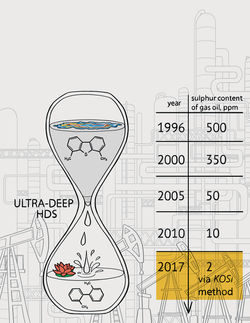Agilent Technologies introduces first method for determining total sulfur and sulfur species in gasoline
Advertisement
Agilent Technologies Inc. (NYSE: A) today announced a method for characterizing sulfur in reformulated gasoline using gas chromatography-inductively coupled plasma mass spectrometry (GC-ICP-MS). This method is the first available technique that can measure both individual sulfur species and total sulfur at the lower levels required by upcoming U.S. and EU regulations. It quantifies individual sulfur species in the low parts-per-billion (ppb) range and total sulfur at less than one part per million (ppm).
The sensitivity of the method provides scientists in the environmental and hydrocarbon processing industries with comprehensive information for regulatory compliance and process control.
Research has implicated sulfur pollution as a contributing factor to a host of environmental and health problems. Sulfur dioxide is a precursor to acid rain, which increases the acidity of soils, lakes and streams; damages plant and animal life; accelerates the corrosion of buildings and monuments; and reduces visibility. Sulfur pollution also poses a risk to human health, as long-term exposure can lead to respiratory and cardiovascular illness.
As a result, the United States and the European Union have mandated increasingly lower permissible levels of total sulfur in motor fuels. In 2004, the U.S. Environmental Protection Agency will begin phasing in new guidelines creating an average sulfur standard of 30 ppm for motor fuels. The EU recently set new regulations requiring the full market availability of sulfur-free fuels (containing less than 10 parts per million sulfur) by Jan. 1, 2005, with the phase-in to be completed by 2009.
This method uses an Agilent 6890 GC with split/splitless injector coupled to an Agilent 7500a ICP-MS with GC-ICP-MS interface. The method displayed excellent sensitivity compared with traditional detection techniques that use sulfur chemiluminescence, flame photometric or atomic emission detectors. Individual sulfur species such as thiophene and 2-methylthiophene were detected at 3 to 10 ppb, with total sulfur detected at approximately 0.1 to 0.5 ppm.
Because of the size and robustness of the ICP-MS plasma, this method virtually eliminates significant analyte signal suppression due to coeluting hydrocarbons. As a result, the GC separation does not need to be compromised to separate analyte and hydrocarbon peaks, and much faster run times can be achieved. Total run time for this method was 12 minutes, compared to the 25 to 30 minutes required when using conventional detectors.
Additionally, since ICP-MS is a scanning, elemental detector, this method can be used for simultaneous detection of other volatile organometallic species in fuels. This can provide important additional information about fuel quality and process control without added investment in time or equipment.
Topics
Organizations
Other news from the department research and development

Get the chemical industry in your inbox
By submitting this form you agree that LUMITOS AG will send you the newsletter(s) selected above by email. Your data will not be passed on to third parties. Your data will be stored and processed in accordance with our data protection regulations. LUMITOS may contact you by email for the purpose of advertising or market and opinion surveys. You can revoke your consent at any time without giving reasons to LUMITOS AG, Ernst-Augustin-Str. 2, 12489 Berlin, Germany or by e-mail at revoke@lumitos.com with effect for the future. In addition, each email contains a link to unsubscribe from the corresponding newsletter.
Most read news
More news from our other portals
See the theme worlds for related content
Topic world Gas chromatography
Gas chromatography is an essential method in analytical chemistry for the separation and analysis of volatile compounds. Due to its high resolution and sensitivity, it has become firmly established in areas such as environmental analysis, food chemistry or forensic science. GC provides precise and reliable results and enables deep insights into the chemical composition of samples.

Topic world Gas chromatography
Gas chromatography is an essential method in analytical chemistry for the separation and analysis of volatile compounds. Due to its high resolution and sensitivity, it has become firmly established in areas such as environmental analysis, food chemistry or forensic science. GC provides precise and reliable results and enables deep insights into the chemical composition of samples.
Topic World Mass Spectrometry
Mass spectrometry enables us to detect and identify molecules and reveal their structure. Whether in chemistry, biochemistry or forensics - mass spectrometry opens up unexpected insights into the composition of our world. Immerse yourself in the fascinating world of mass spectrometry!

Topic World Mass Spectrometry
Mass spectrometry enables us to detect and identify molecules and reveal their structure. Whether in chemistry, biochemistry or forensics - mass spectrometry opens up unexpected insights into the composition of our world. Immerse yourself in the fascinating world of mass spectrometry!
























































